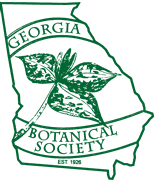
The Georgia Botanical Society
Dedicated
to the study and preservation of Georgia's wild, native,
rare and endangered wildflowers and plant life
You've reached an old page of our web site. Please visit www.gabotsoc.org for our current site.
Articles-Places:
Track Rock Gap
click
here for printer-friendly version
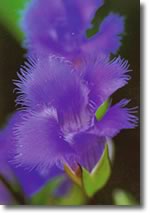 The
geology of Track Rock Gap has spawned two rarities in Georgia: ancient, undeciphered
petroglyphs, and the beautiful, threatened Fringed Gentian (Gentianopsis
crinita). The geology has also caused the formation of peculiar soils
that in turn support unusual plant communities. The interesting relationships
between the geology, soils, and plants found in places like Track Rock Gap
are described below.
The
geology of Track Rock Gap has spawned two rarities in Georgia: ancient, undeciphered
petroglyphs, and the beautiful, threatened Fringed Gentian (Gentianopsis
crinita). The geology has also caused the formation of peculiar soils
that in turn support unusual plant communities. The interesting relationships
between the geology, soils, and plants found in places like Track Rock Gap
are described below.
Click for more information on the Fringed
Gentian from the Georgia Plant Conservation Alliance.
Photo: The Fringed Gentian (Gentianopsis crinita) © Hugh and Carol Nourse
Geology
Here at Track Rock Gap in the Blue Ridge Mountains, you are actually standing
on rock that was once below an ocean's crust. Formed at great depths, it
was thrust upon the continent during closing of the pre-Atlantic ocean (Iapetus)
and the formation of Pangaea roughly 300 million years ago. 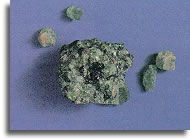 The
minerals composing the Earth, from the core to the crust, are sorted by
density; that is, as the Earth formed, heavy minerals migrated toward the
core and lighter minerals frothed to the Earth's surface. Thus, the Track
Rock Gap rocks - formed at great depths - contain dark, heavy minerals such
as olivene, pyroxene, serpentine and talc.(Serpentine is formed when pyroxene
and olivine minerals, common in peridotite rock beneath the ocean crust,
are heaved up by plate tectonics and altered to serpentine by ocean water
and decreased heat and pressure. Rocks that abound with this mineral are
called serpentinites. Soapstone, the talc-rich material upon which the petroglyphs
are etched, is a soft, carvable rock related to serpentine.)
The
minerals composing the Earth, from the core to the crust, are sorted by
density; that is, as the Earth formed, heavy minerals migrated toward the
core and lighter minerals frothed to the Earth's surface. Thus, the Track
Rock Gap rocks - formed at great depths - contain dark, heavy minerals such
as olivene, pyroxene, serpentine and talc.(Serpentine is formed when pyroxene
and olivine minerals, common in peridotite rock beneath the ocean crust,
are heaved up by plate tectonics and altered to serpentine by ocean water
and decreased heat and pressure. Rocks that abound with this mineral are
called serpentinites. Soapstone, the talc-rich material upon which the petroglyphs
are etched, is a soft, carvable rock related to serpentine.)
Photo: Olivene (from Modern Physical Geology by G.R. Thompson and J. Turk)
These
minerals have high amounts of the elements of magnesium and iron, and are
called ultra-mafic rocks.
(The word mafic stands for magnesium (ma), and iron, or ferrum (f).
Ultra-mafic means particularly high amounts of these elements.) Often,
other heavy elements, such as nickel and chromium, are present in ultra-mafic
rocks.
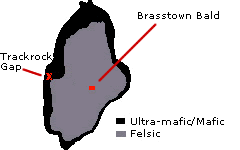 The
area surrounding Brasstown Bald is a melange of mafic and ultra-mafic minerals,
creating a mosaic of geologic and soil conditions. The mafic rocks may create
fertile, nutrient rich soils, while the ultra-mafic rocks may create conditions
hostile to many plants.
The
area surrounding Brasstown Bald is a melange of mafic and ultra-mafic minerals,
creating a mosaic of geologic and soil conditions. The mafic rocks may create
fertile, nutrient rich soils, while the ultra-mafic rocks may create conditions
hostile to many plants.
Soils
Ultra-mafic rock outcrops are not common on the earth's surface, and the soils they form - often called serpentine soils by ecologists - are unusual, with several defining characteristics. First, they tend to be low in plant nutrients such as phosphorus, potassium, nitrogen and calcium. Second, they have unusually high magnesium levels and high magnesium to calcium ratios. The high levels of magnesium in the soil block most plants' abilities to take up other nutrients, especially calcium. Third, nickel or chromium can be present in levels toxic to plants. Fourth, the soils contain minerals formed deep in the earth that are no longer in equilibrium with their surroundings and are easily eroded. The erosion creates a distinctive, pocked landscape described by Charles Wharton as looking as though meteorites have hit it. These eroded, thin soils do not retain very water well. Finally, these soils are typically low in clay. One clay that does form, montmorillite, binds water to it so tightly that vegetation cannot access the water.
All of these factors render the serpentine soils low in both moisture and nutrients, creating difficult conditions for plants. Hence, the vegetation is often thinly dispersed, so nitrogen and organic humus cannot build in the soil and the area remains open and hot, perpetuating the unfavorable conditions.
Plant adaptations and communities
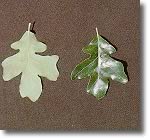 The
difficult environment - sometimes called the "serpentine syndrome"
- encourages plants that have evolved special adaptations to low moisture
and nutrient levels. Some plants have developed greater efficiencies in
absorbing calcium; others, such as Post oak (Quercus stellata) and
Blackjack oak (Quercus marilandica) selectively accumulate calcium.
Little Bluestem grass (Schizachyrium scoparium) rolls its leaves
to minimize water loss. Some species have a thick covering of hair on their
stems and leaves to reflect excessive sunlight and trap humidity; others
have waxy leaves to retain moisture.
The
difficult environment - sometimes called the "serpentine syndrome"
- encourages plants that have evolved special adaptations to low moisture
and nutrient levels. Some plants have developed greater efficiencies in
absorbing calcium; others, such as Post oak (Quercus stellata) and
Blackjack oak (Quercus marilandica) selectively accumulate calcium.
Little Bluestem grass (Schizachyrium scoparium) rolls its leaves
to minimize water loss. Some species have a thick covering of hair on their
stems and leaves to reflect excessive sunlight and trap humidity; others
have waxy leaves to retain moisture.
Photo: Quercus stellata (Post oak) (From Trees of Georgia and Adjacent States by Claud.L. Brown and L. Katherine Kirkman)
Thus, a special community of plants that has adapted to harsh conditions develops on some ultra-mafic soils. The communities are called Serpentine Barrens or Serpentine Woodlands, because they are often found and studied on serpentine rock. Often these communities have an unusually high percentage of rare plants - rare either because they have evolved unusual adaptations to the ultra-mafic soils, or simply because they are out-competed by other plants in more favorable environments. Track Rock Gap is special not only because of the Fringed Gentian, but also because of the presence of Solidagao bicolor (Silver-rod) and Carex purpurifera (Purple Sedge) and the abundance of at least two other gentians - Gentiana saponaria (Soapwort Gentian) and Gentianella quinquefolia (Stiff Gentian). For a list of typical plants found in such communities in low elevation Blue Ridge environments, see the NatureServe description below.
NatureServe
Description
Low Elevation Blue Ridge Serpentine Woodland (NatureServe)
Classification
Scientific Name: Pinus virginiana - Pinus rigida - Quercus stellata
/ Ceanothus americanus - Kalmia latifolia / Thalictrum revolutum Woodland
Translated Scientific Name: Virginia Pine - Pitch Pine - Post Oak / New
Jersey-tea - Mountain Laurel / Skunk Meadowrue Woodland
Association Summary: This community includes pine-oak woodlands over serpentine, olivine, dunite, and other ultramafic rocks, at elevations from 1800-3100 feet, in the Southern Blue Ridge mountains of North Carolina and extreme northern Georgia. The open canopy is typically dominated by Pinus virginiana, Pinus rigida, Pinus strobus, Quercus stellata, Quercus rubra, and Quercus falcata (lower elevations only), with other species including Sassafras albidum, Acer rubrum var. rubrum, Betula lenta, Liriodendron tulipifera, Nyssa sylvatica, and Oxydendrum arboreum. Typical shrub and woody vine species are Ceanothus americanus, Cornus florida, Kalmia latifolia, Castanea pumila, Gaultheria procumbens, Gaylussacia baccata, Lyonia ligustrina var. ligustrina, Parthenocissus quinquefolia, Pyrularia pubera, Rhododendron calendulaceum, Rhododendron maximum, Smilax rotundifolia, and Vaccinium stamineum. The herb layer can be very well-developed or patchy, and in more open examples can be graminoid-dominated. Typical herbaceous species are Thalictrum revolutum, Ageratina aromatica, Anemone virginiana, Asclepias verticillata, Asplenium platyneuron, Symphyotrichum patens var. patens (= Aster patens var. patens), Campanula divaricata, Chimaphila maculata, Chrysopsis mariana, Coreopsis major, Danthonia sericea, Danthonia spicata, Dichanthelium spp., Erigeron pulchellus, Erigeron strigosus, Euphorbia corollata, Houstonia purpurea, Hypericum punctatum, Lespedeza hirta, Lespedeza procumbens, Liatris spicata, Linum virginianum, Osmunda regalis var. spectabilis, Polystichum acrostichoides, Pteridium aquilinum var. latiusculum, Schizachyrium scoparium, Scleria ciliata, Sisyrinchium angustifolium, Sisyrinchium mucronatum, Solidago arguta var. caroliniana, Triosteum perfoliatum, and Viola pedata. At the lowest elevation occurrences, additional typical species include Symphyotrichum dumosum (= Aster dumosus), Cheilanthes lanosa, Desmodium ciliare, Desmodium nudiflorum, Desmodium rotundifolium, Melica mutica, Mimosa microphylla (= Mimosa quadrivalvis var. angustata), Piptochaetium avenaceum, Pityopsis graminifolia, Polygala polygama, and Solidago odora var. odora. In an example from the Chattahoochee National Forest, the herbaceous layer is dominated by Thalictrum macrostylum. Other characteristic herbs include Schizachyrium scoparium, Sorghastrum nutans, Andropogon gerardii, Osmunda regalis, Asclepias verticillata, Helianthus microcephalus, Panicum virgatum, Solidago odora, Euphorbia corollata, Ageratina aromatica, Eryngium yuccifolium, and Coreopsis major.
Global
Heritage Status Rank: G1
Global Heritage Status Rank Reasons: This serpentine woodland is
described from a small number of sites at low elevations in the Southern
Blue Ridge of Georgia and North Carolina. Serpentine (or other ultramafic)
lithology is necessary for development of this community type, and there
are very limited exposures of suitable rocks in the Southern Blue Ridge.
Several of the known locations where this community occurred have been destroyed
by mining or altered by logging. None of the known locations have protected
status.
Global Range Comments: This community occurs in the Southern Blue
Ridge mountains of North Carolina and extreme northern Georgia.
NatureServe Explorer: An online encyclopedia of life [web application]. 2001. Version 1.6 . Arlington, Virginia, USA: NatureServe. Available: http://www.natureserve.org/explorer. (Accessed: September 9, 2002 ).
Copyright (c) 2001 NatureServe, 1101 Wilson Boulevard, 15th Floor, Arlington Virginia 22209, U.S.A. All Rights Reserved.
Text by Leslie Edwards. Please send comments to lesedw@earthlink.net.
Geologic information within the text was kindly reviewed and supplemented
by John Costello of the Georgia Geologic Society.
Botanical information was kindly reviewed and supplemented by Tom Patrick,
of the Georgia Natural Heritage Program.
Anita Reaves, Membership Chair
770-827-5186
All contents
of this website(except where otherwise noted) ©2002-2007 Georgia Botanical
Society. All rights reserved.
The Georgia Botanical Society is a private non-profit organization under IRS
501(c)3, Founded in 1926.
Questions, comments or problems with this website, please contact: webmaster@gabotsoc.org
Home | Newsletter | Field Trips | Tipularia | Links | Articles | Contact Us | Join!